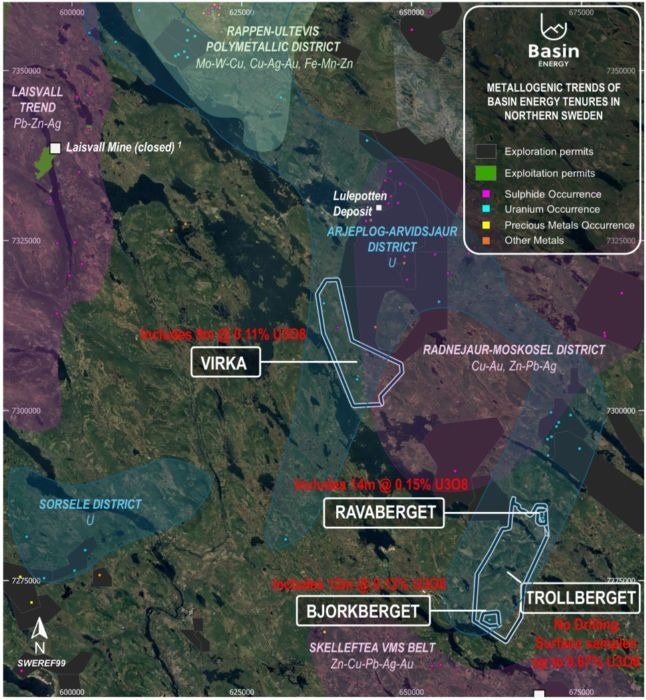Basin Energy Limited is pleased to report that re-assaying of historical diamond drill core has confirmed significant uranium mineralization across all three of its North Sweden Projects (Björkberget, Rävaberget and Virka) validating and expanding upon historic Swedish Geological Survey (SGU) data.
 Location map of Basin’s Projects in northern Sweden with drilling highlights per prospect, in relation to known uranium districts and mineral occurrences as reported by the Swedish Geological Survey. Image Credit: Basin Energy Limited
Location map of Basin’s Projects in northern Sweden with drilling highlights per prospect, in relation to known uranium districts and mineral occurrences as reported by the Swedish Geological Survey. Image Credit: Basin Energy Limited
The results, derived from modern geochemical sampling and data validation of 59 historical drillholes, confirm substantial uranium intervals and validate the quality of legacy data. The mineralization remains open along strike and at depth across all project areas.
Key Highlights
- Re-assaying validates and infills historic data, confirming significant mineralization at three project areas in northern Sweden.
- Björkberget (Bjork) – shear-hosted mineralization including:
- 12 m at 0.12 % U3O8 from 42.5 m, including 4 m at 0.23 % U3O8 from 46 m (BJK78002)
- 2.5 m at 0.27 % U3O8 from 169.5 m (BJK78001)
- Rävaberget (Rava) – thick intervals including:
- 14.4 m at 0.15 % U3O8 from 16.1 m (RVB76003)
- Mineralization remains open at depth with 20 km of prospective ground staked between Rava and Bjork.
- Virka Project – additional high-grade intersections including:
- 2.6 m at 0.15 % U3O8 from 27.8 m (VIR80005)
- 0.5 m at 0.66 % U3O8 from 26.3 m (VIR80013)
- Mineralization remains open along strike to the southwest and down dip.
- Sweden’s uranium exploration ban is scheduled for removal in January 2026, positioning Basin to capitalize on renewed European uranium opportunities.
The program confirms Basin’s early-mover advantage in a region with proven uranium fertility and excellent infrastructure. The North Sweden Projects lie within the Fennoscandian Shield — a metallogenic province that also hosts volcanogenic massive sulphide (VMS) and orogenic gold deposits.
Managing Director, Pete Moorhouse Commented:
“These results demonstrate the presence of an active mineralizing system across three project areas each capable of producing significant thickness and grades of uranium mineralization. The work completed in the 1970s and 80s was of good caliber, however, it was tightly focussed on the limited areas of outcrop. The two best intervals occur at Rava and Bjork, with Basin staking the entire 20 kilometers of prospective ground between these two prospects, which has never seen a drill hole.
With the upcoming policy change in Sweden paving the way to the next phase of uranium opportunity, Basin will use this data along with its in house uranium exploration expertise to explore along strike, to realise the scale of potential for the district. Basin Energy’s early-mover advantage, positions the Company to be at the forefront of a revitalized European uranium and critical minerals sector, supporting the continent’s shift toward secure, low-carbon energy supply chains.”
Next Steps
Basin plans to integrate the newly validated historical data into its geological models ahead of upcoming fieldwork and drill targeting. The Company intends to conduct follow-up mapping, sampling, and airborne geophysics during the 2026 field season, once Sweden’s policy changes formally enable uranium exploration.
These results reinforce Basin’s view that its North Sweden portfolio has district-scale uranium potential in a Tier-1 jurisdiction at a time when European nations are strengthening domestic supply of low-carbon energy metals.